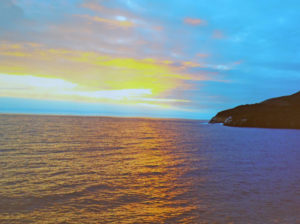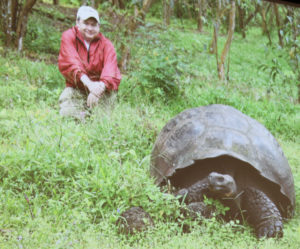By Page H. Gifford, Correspondent
Local traveler John Day presented to the Lake Monticello Wildlife Committee Dec. 2 about his trip to the Galapagos Islands.
“I was always interested in zoology and this was a trip that was on my bucket list,” said Day.
 He began his trip in Ecuador and discussed some of the customs that make up Ecuadorian culture, including making papier-mâché toys to burn at New Year’s instead of fireworks. After his brief visit, he boarded a tour boat with 40 fellow passengers to visit some of the hundreds of islands that make up the Galapagos in the Pacific, a province of Ecuador.
He began his trip in Ecuador and discussed some of the customs that make up Ecuadorian culture, including making papier-mâché toys to burn at New Year’s instead of fireworks. After his brief visit, he boarded a tour boat with 40 fellow passengers to visit some of the hundreds of islands that make up the Galapagos in the Pacific, a province of Ecuador.
There were a variety of activities for wildlife viewing, including walking, hiking, kayaking, snorkeling and traveling in a boat with a glass bottom. Decked out in his hiking boots, armed with his telescopic walking stick and Nikon camera, Day was ready to tour the islands. Between wet landings on the beach, perilous walks through rocky terrain, kayaking and snorkeling, one has to be in shape and have a significant amount of determination to participate.
Trying to get in and out of the pangas (inflatable boats) or even trying to mount rocks on dry land in a dry landing requires some physical skill, but Day said there was always someone there who would help. Day opted to view the aquatic life through the glass bottom boat instead of snorkeling since it had been a few years since he had been diving.
During a wet landing on the beach, the travelers were greeted by views of sea lions napping in the sun. Day caught one mother and her cub snoozing with his Nikon. As the island was made up of layers of volcanic rock, trekking could be perilous without a stick, particularly when climbing up the steep, rocky path on the side of the volcanic hillside.
“It had rails,” Day pointed out in his picture. It is clear why the Galapagos are considered one of the world’s best destinations for wildlife viewing. After Charles Darwin visited the Galapagos in 1835 aboard the famous voyage of the Beagle, the species living on the Galapagos became the inspiration for his theory of evolution.
“There were iguanas everywhere,” said Day, adding that they were as abundant as squirrels are in America. They lay on every inch of rocky landscape, underbrush or any other unoccupied space.
“When Charles Darwin arrived here he stated that there were so many iguanas that you couldn’t pitch a tent without hitting one,” Day said.
 As the tour proceeded throughout the islands, they walked past nazca booby, red footed and blue footed booby, hawks, flamingos, frigate birds, Galapagos penguins, cactus finches, albatrosses, and even the rainbow-colored sally lightfoot crabs sunning themselves on the rocks. One photo showed Day squatting in the distance, watching the famous giant tortoise.
As the tour proceeded throughout the islands, they walked past nazca booby, red footed and blue footed booby, hawks, flamingos, frigate birds, Galapagos penguins, cactus finches, albatrosses, and even the rainbow-colored sally lightfoot crabs sunning themselves on the rocks. One photo showed Day squatting in the distance, watching the famous giant tortoise.
One audience member asked if any people inhabit the islands.
“Out of the hundreds of islands only a few have a fresh water source, but most of them will not sustain human settlement,” he said. “UNESCO does a fine job on conservation.” The United Nations Educational, Scientific and Cultural Organization (UNESCO) preserves world heritage sites like the Galapagos Islands, which have cultural, historical, scientific and other significance and are legally protected under international treaties. The world heritage sites are judged for their collective interest to mankind. Perhaps Darwin’s theory of evolution fits the criteria for the preservation of the Galapagos.




